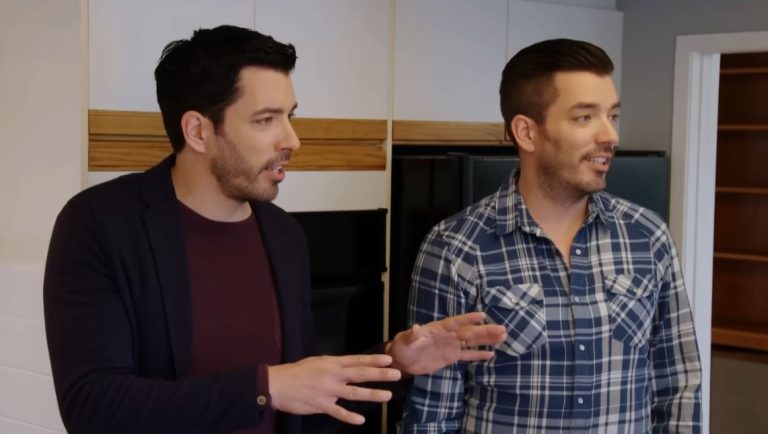Two males. Just one vision. As well as a ton of tile. Two of the most significant personalities in North American home design television are Jonathan and Drew Scott, who have achieved this quietly but effectively. They look strikingly alike, but they have different roles—one renovates, the other negotiates—and they have created more than just gorgeous kitchens. In an industry that was previously dominated by stiff hosts and dry narration, they have created a brand that has remarkably outlasted early skepticism.
Their experience has significantly changed how people view home remodeling over the last ten years, turning it from a tense ordeal into an optimistic undertaking. Real estate served as both a stepping stone and a stage for Drew, whose early aspirations leaned toward acting. For Jonathan, who had previously been interested in magic and illusion, carpentry and design provided a more concrete form of metamorphosis. Their combination of performative and practical skills has proven to be highly adaptable, allowing them to interact with clients in a natural way and produce extremely effective outcomes.
Property Brothers – Biography and Career Summary
| Name | Jonathan Silver Scott and Drew Scott |
|---|---|
| Birthdate | April 28, 1978 |
| Birthplace | Vancouver, British Columbia, Canada |
| Profession | TV Hosts, Real Estate Experts, Entrepreneurs |
| Education | Jonathan: SAIT Polytechnic |
| Primary Show | Property Brothers (since 2011) |
| Business Entity | Scott Brothers Entertainment |
| Marital Status | Jonathan: Dating Zooey Deschanel |
| Notable Recognition | Leo Award winners, Emmy-nominated |
| Social Reach | 2M+ on Instagram, 1.1M on Facebook |
When Property Brothers made its Canadian premiere in 2011 and was later syndicated to the United States by HGTV, it became their big break. The idea was straightforward but captivating: display an ideal house that is just out of reach, then switch to a less expensive fixer-upper and transform it into something similar. The show appealed to both first-time purchasers and serial movers by emphasizing the benefits of vision over perfection.
The pair adapted to local housing styles and economic conditions while filming across North America through strategic partnerships and unrelenting production schedules. Before a single nail was driven, Jonathan would show families his imagined designs by using computer-generated imagery. These NEEZO Studios-created renderings, which give the renovation process remarkable clarity, have come to be recognized as one of the show’s visual hallmarks.
The brothers’ upbeat tale seems especially relevant in light of the fluctuating cost of housing. They sell belief in addition to design. the conviction that your ideal home can still be found, even in the face of aging architecture or growing mortgage rates. And a large number of viewers have replied. They have continuously been rated as one of HGTV’s best-performing series, and international streaming agreements have allowed them to be seen in more than 150 nations.
However, there have been some criticisms along the way. Contractors frequently doubt that their budgets and schedules are realistic. Critics claim that the overly trendy options, open concepts, and frequent use of white kitchens can come across as formulaic. Deconstruction scenes that fail to consider recycling opportunities have drawn criticism from environmental advocates. Nevertheless, there is no denying the show’s positive influence. They’ve greatly lessened the fear of real estate endeavors by making homeownership seem exciting and attainable.
But their true power might be off-screen. The twins have secured long-term profitability and creative autonomy by purchasing complete control of the Property Brothers franchise through Scott Brothers Global. In a field where artists frequently lose ownership of their work, this choice represents a particularly creative strategy. Their foray into product lines, mobile applications, and books only serves to strengthen the sustainability of their brand.
They have also attracted new audiences thanks to their celebrity connections. Jonathan’s public image has been subtly transformed from a hammer-wielding contractor to a Hollywood-adjacent hottie thanks to his relationship with actress Zooey Deschanel. In the meantime, viewers have been able to see a glimpse of the polished negotiator’s personal life through Drew’s marriage to creative director Linda Phan. Because of these characteristics, they are public figures with complex identities and values rather than just TV personalities.
What’s particularly fascinating is how the show quietly captures larger changes in society. Property Brothers, a portrayal of domestic stability wrapped in subway tile and crown molding, has been a comfort as American cities struggle with affordability. The aspiration itself is a part of the experience, even though not everyone can accomplish what they deliver. It’s a kind of design optimism that feels empowering despite being idealized.
Their success reflects a broader trend of home improvement and do-it-yourself projects that gained momentum during the pandemic. Families who were confined inside started to envision their spaces more expansively, and the Scott brothers’ collection of concepts evolved into a virtual haven. Even as new talent enters the market, their ability to adapt across print, social media, and streaming has kept them extremely relevant.
Their mannerisms, however, are perhaps what make them most charming. Jonathan and Drew are remarkably calm, whether they are dealing with unexpected rot behind drywall or a couple arguing over tile samples as if it were a federal issue. Their allure isn’t merely aesthetic; it’s what ties every nail, light fixture, and pressing deadline together.
They do more than just flip a house with every renovation. Families are quietly told, “You’re worth this investment.” Fans return because of that ethos, which is presented with authenticity and supported by twenty years of real estate and design expertise. Granite worktops aren’t the point. With a floor plan, it’s all about hope.


